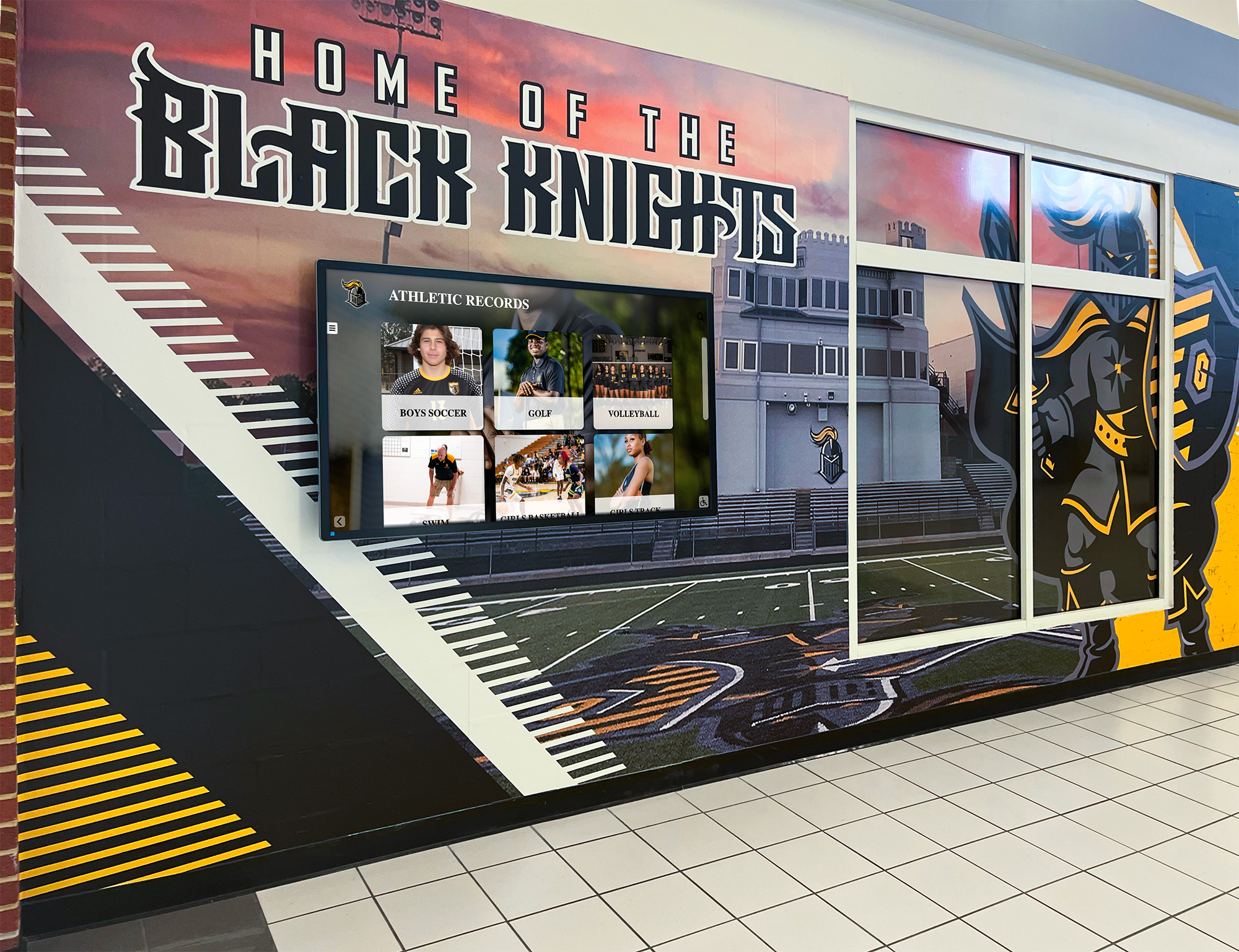School records tell powerful stories. They celebrate breakthrough performances, chronicle program evolution, and inspire future athletes to chase excellence. Yet for decades, traditional record boards have created significant challenges for schools: they’re difficult and expensive to update, space limitations force tough choices about what to display, and maintaining accuracy requires constant vigilance and physical labor.
Digital record boards solve these persistent problems while transforming how schools recognize athletic achievement. These interactive touchscreen systems make displaying and maintaining school records remarkably simple, eliminating the frustration of outdated information and providing unlimited capacity to showcase every significant accomplishment across all sports programs.
This comprehensive guide explores how Rocket Alumni Solutions provides the perfect digital record board solution, why these systems are so easy to update and maintain, the specific benefits schools experience after implementation, and practical strategies for transitioning from traditional record boards to modern digital displays.
The Traditional Record Board Challenge
Before exploring digital solutions, it’s important to understand why traditional record boards create such persistent headaches for athletic directors and coaches across the country.
Update Complexity and Costs
Traditional record boards require physical updates every time a record falls. This process typically involves:
Material and Labor Requirements:
- Ordering new vinyl lettering or engraved plaques (2-4 week lead times typical)
- Hiring professionals for installation or dedicating staff time
- Removing old records and installing new ones (30-90 minutes per record)
- Ensuring correct alignment, spacing, and appearance
- Managing inventory of backup materials and supplies
A single record update on a traditional board commonly costs $50-150 when accounting for materials, labor, and administrative time. Schools with active athletic programs may need 15-30 updates annually across various sports, creating cumulative costs of $750-4,500 per year just for routine record maintenance.
These costs don’t include major board refurbishment required every 5-7 years as vinyl fades, materials deteriorate, and visual standards decline. Complete board replacement or restoration often runs $3,000-8,000 depending on size and scope.
Space Limitations Force Difficult Choices
Physical record boards have fixed capacity. A typical athletic record board displays 30-60 records across multiple sports, forcing athletic directors to make impossible decisions:
- Display only varsity records or include JV achievements?
- Show records from the last 20 years or include historical marks from decades past?
- Feature individual records only or also recognize relay teams?
- Limit to school records or include conference and state qualifying performances?
- Allocate space equally across all sports or emphasize major programs?
These constraints mean many significant achievements never receive public recognition simply because there’s nowhere to display them. The 50-meter freestyle record from 1987 might be phenomenal, but if the board only shows records from the last 15 years, that achievement becomes invisible to current students.

Accuracy and Consistency Challenges
Maintaining accurate records across traditional boards presents ongoing challenges:
Common Accuracy Problems:
- Records broken during season don’t appear on boards until off-season updates
- Coaching changes result in lost institutional knowledge about historical records
- Inconsistent formatting across different boards as various people make updates over years
- Difficulty verifying accuracy of decades-old records when original documentation is lost
- Multiple sports using different measurement units, abbreviations, or naming conventions
Many schools discover significant errors when auditing traditional record boards—incorrect years, misspelled names, inaccurate times or distances, or achievements attributed to wrong athletes. Correcting these errors requires the same costly physical update process.
Maintenance and Deterioration
Physical record boards deteriorate over time:
- Vinyl lettering fades in sunlight or peels from temperature fluctuations
- Engraved plaques tarnish or become difficult to read
- Wood backing warps or sustains water damage
- Display lighting fails and requires electrical work to replace
- Glass or acrylic covers scratch, crack, or develop haze
Regular maintenance—cleaning, minor repairs, lighting replacement—adds hundreds of dollars in annual costs even without record updates. Eventually, deterioration reaches a point where complete board replacement becomes necessary despite the substantial investment.
Why Digital Record Boards Are the Perfect Solution
Digital record boards address every limitation of traditional systems while introducing powerful new capabilities that transform how schools recognize athletic achievement.
Remarkably Easy to Update
The most significant advantage of digital record boards is their update simplicity. When a record falls, updating a digital system takes minutes instead of hours or days:
Simple Update Process:
- Log into cloud-based content management system from any device
- Navigate to the sport and record category
- Edit the existing record or create a new entry
- Upload a photo of the athlete if available
- Click publish—changes appear on the display immediately
No special skills required. No waiting for materials. No physical installation. The athletic director who can send an email can update digital record boards.
This simplicity means records stay current throughout the season. Break a school record on Friday night, update the digital board Saturday morning, and students see it celebrated Monday when they return to school. This immediacy maximizes the motivational impact of recognition.
Many schools implementing Rocket Alumni Solutions report that the person managing record updates changes from “whoever has time to deal with the physical board update” to “anyone on the coaching or athletic staff” because the process is so straightforward that no specialized knowledge is necessary.
Minimal Maintenance Requirements
Digital record boards require dramatically less maintenance than traditional physical boards:
Ongoing Maintenance Needs:
- Periodic screen cleaning (similar to cleaning glass on traditional boards)
- Standard IT support for network connectivity and software updates
- Occasional hardware checks to ensure proper operation
That’s essentially it. No vinyl to replace, no engraving to order, no physical installation labor, no materials inventory to manage. The systems run reliably with minimal intervention.
Commercial-grade touchscreen displays used in quality digital record board systems are designed for continuous operation in public spaces. They typically carry 50,000+ hour operating ratings—that’s over 15 years of 8-hour daily use. Hardware warranties commonly cover 3-5 years, and professional systems include technical support ensuring prompt issue resolution when needed.
Software updates happen automatically in the cloud, adding features and capabilities without requiring action from school staff. Content remains secure with automatic cloud backups, protecting against data loss from hardware failures or other issues.
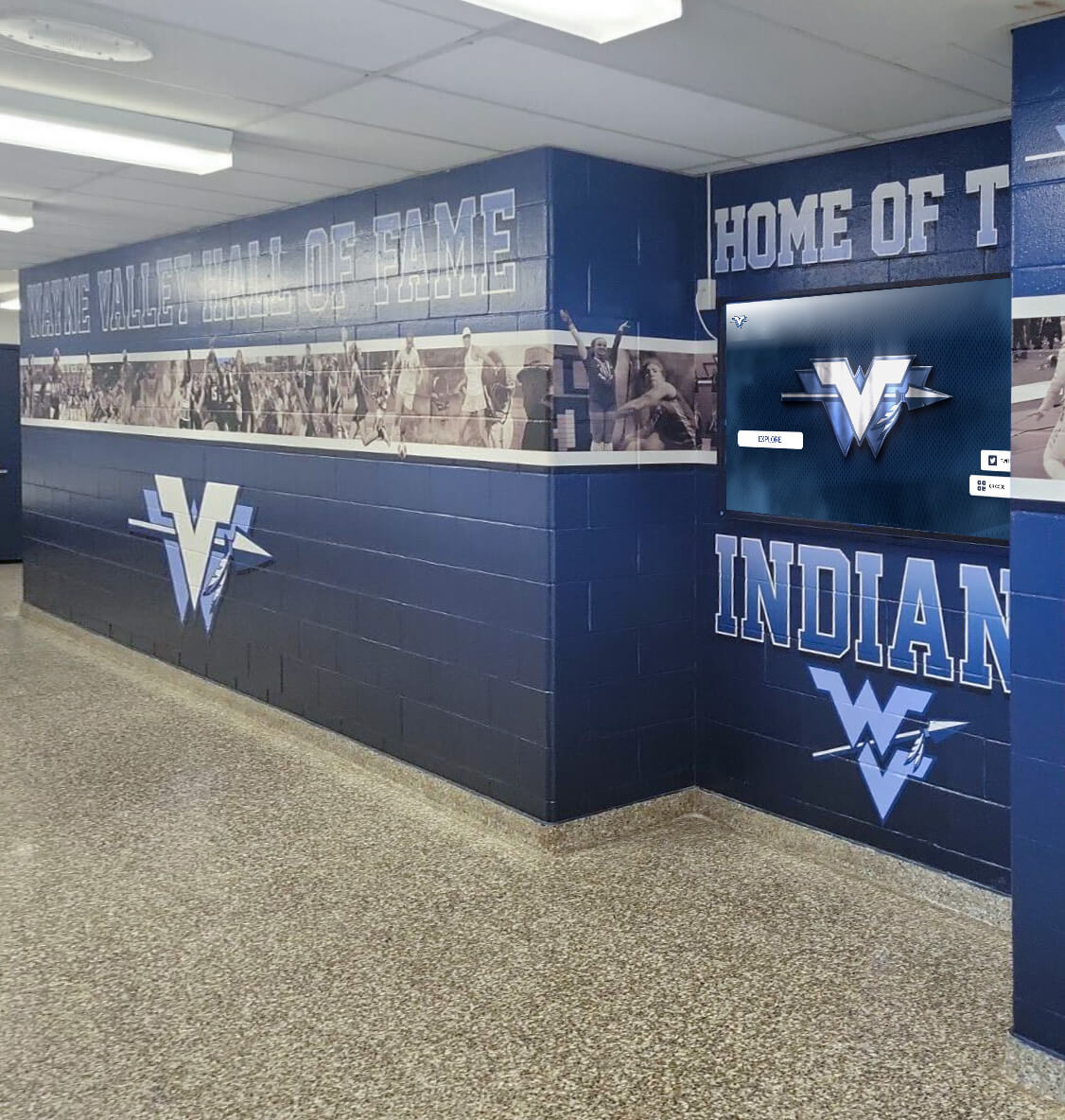
Unlimited Capacity for Comprehensive Recognition
Digital platforms eliminate space constraints entirely. A single touchscreen display can showcase:
- Individual records in every event for every sport
- Team records and championship achievements
- Varsity, junior varsity, and freshman records
- Historical records spanning school history
- Conference records, sectional records, and state qualifying marks
- Relay team records with full roster information
- Multi-sport athlete recognition across programs
Schools commonly display 500-1,000+ records on digital systems compared to the 30-60 records possible on traditional physical boards. This comprehensive coverage ensures every significant achievement receives appropriate recognition.
Interactive search and filtering make this extensive content accessible rather than overwhelming. Students can search by sport, year, athlete name, or record type—finding specific information instantly rather than visually scanning crowded displays.
Solutions like digital record board platforms designed specifically for high schools provide pre-built category structures for all major sports, making it easy to organize even extensive record collections systematically.
Rich Context and Storytelling
Traditional record boards show minimal information—typically just names, marks, and years. Digital record boards enable comprehensive storytelling:
Enhanced Record Presentations:
- Athlete photos showing individuals at the time of achievement
- Multiple records held by the same athlete linked together
- Season context—conference championships, state meet placements, team records
- Video highlights of record-breaking performances when available
- Coach profiles and career records for programs
- Historical photos showing program evolution over decades
- Statistical progression showing how records improved over time
This rich context transforms record displays from simple data lists into compelling narratives that engage viewers emotionally and inspire appreciation for athletic excellence.
For instance, a simple “Sarah Johnson - 100m Dash - 12.14 - 2019” entry on a traditional board becomes a comprehensive profile on a digital system: multiple photos of Sarah, her complete track career statistics, the story of her state championship race where she set the record, video of the performance, her college running career update, and connections to other school sprint records she approached or broke. This depth creates meaningful engagement impossible with traditional displays.
Cost-Effective Long-Term Solution
While digital record boards require higher upfront investment than traditional boards, the total cost of ownership over 10-15 years typically favors digital solutions:
Traditional Board 10-Year Costs:
- Initial board: $3,000-6,000
- Annual updates (20 records average @ $100 each): $20,000
- Mid-cycle refurbishment: $3,000-5,000
- Annual maintenance and materials: $2,000-3,000
- 10-Year Total: $31,000-52,000
Digital Board 10-Year Costs:
- Initial hardware and software: $10,000-18,000
- Annual software subscription: $6,000-12,000 (10 years)
- Minimal maintenance: $1,000-2,000
- 10-Year Total: $17,000-32,000
Beyond financial savings, digital systems provide dramatically more capability—unlimited capacity, multimedia content, interactive features, and instant updates—making the value proposition even more compelling.
Many schools fund digital record board implementations through athletic booster clubs, alumni associations, or naming opportunities for display sponsorships, avoiding budget impact while modernizing recognition capabilities.

How Rocket Alumni Solutions Makes Digital Record Boards Simple
Rocket Alumni Solutions has specifically designed its digital record board platform to address the needs of schools, athletic directors, and coaches who want comprehensive recognition without technical complexity.
Intuitive Content Management System
The Rocket Alumni Solutions content management system requires no technical training. The interface uses familiar patterns from social media and word processing:
User-Friendly Features:
- Dashboard showing all sports and record categories at a glance
- Simple forms for adding or editing records (similar to filling out any web form)
- Drag-and-drop photo uploads
- Preview mode to see exactly how records will appear before publishing
- Bulk import tools for adding multiple records efficiently
- Template system ensuring consistent formatting automatically
- Search and filter tools finding specific records instantly
Schools report that new athletic directors or coaches become comfortable managing the system within 30 minutes of initial orientation. No ongoing technical support needed for routine record updates—it’s truly that straightforward.
Pre-Built Sports Templates
Rather than starting from scratch, Rocket Alumni Solutions provides professional templates for all major sports:
Ready-to-Use Sport Structures:
- Track & Field - separate categories for sprints, distance, hurdles, jumps, throws, relays
- Swimming & Diving - organized by strokes, distances, relay events
- Cross Country - course records, meet championships, season best times
- Basketball - scoring, rebounds, assists, steals, blocks, three-pointers
- Football - rushing, passing, receiving, defensive, kicking, team records
- Soccer - goals, assists, shutouts, saves, team achievements
- Wrestling - pins, wins, tournament placements, weight class records
- And templates for 30+ other sports commonly found in high school programs
These templates follow best practices developed across hundreds of school implementations, ensuring your records display professionally and comprehensively from day one.
Automated Organization and Display
The system automatically handles technical aspects of record organization:
- Records sort correctly by performance (times, distances, heights, scores)
- Athlete names link to profile pages showing all their achievements
- Sports group by season (fall, winter, spring) for easy seasonal updates
- Search indexing updates automatically as new records are added
- Related records connect—team records link to individual member profiles
- Display layouts adjust to screen size and orientation automatically
Athletic directors focus on content—entering records and uploading photos—while the system handles all technical display and organization details.
Comprehensive Support and Training
Rocket Alumni Solutions provides support ensuring schools succeed:
Support Services Included:
- Initial setup assistance and customization
- Staff training on content management system use
- Ongoing technical support for questions or issues
- Regular software updates with new features and improvements
- Content migration assistance when transitioning from traditional boards
- Best practices guidance for maximum engagement
Schools aren’t left to figure things out alone. The Rocket team partners with athletic departments to ensure successful implementations that serve programs effectively for years to come.
Flexible Hardware Options
Different schools have different needs and constraints. Rocket Alumni Solutions works with various hardware configurations:
Installation Options:
- Wall-mounted displays (43"-75" screens) for hallways and gymnasiums
- Freestanding kiosks for lobby areas and athletic complexes
- Outdoor-rated displays for field houses and stadium areas
- Multiple-display networks for comprehensive campus coverage
- Custom enclosures matching school aesthetics and branding
Professional installation services ensure displays are securely mounted, properly connected, and optimally positioned for visibility and engagement. Schools can also choose to handle installation with local contractors if preferred, with Rocket providing detailed specifications and guidance.
The solution works with schools’ existing network infrastructure—WiFi or wired Ethernet—and requires only standard power outlets. No specialized electrical work or dedicated networking typically necessary.
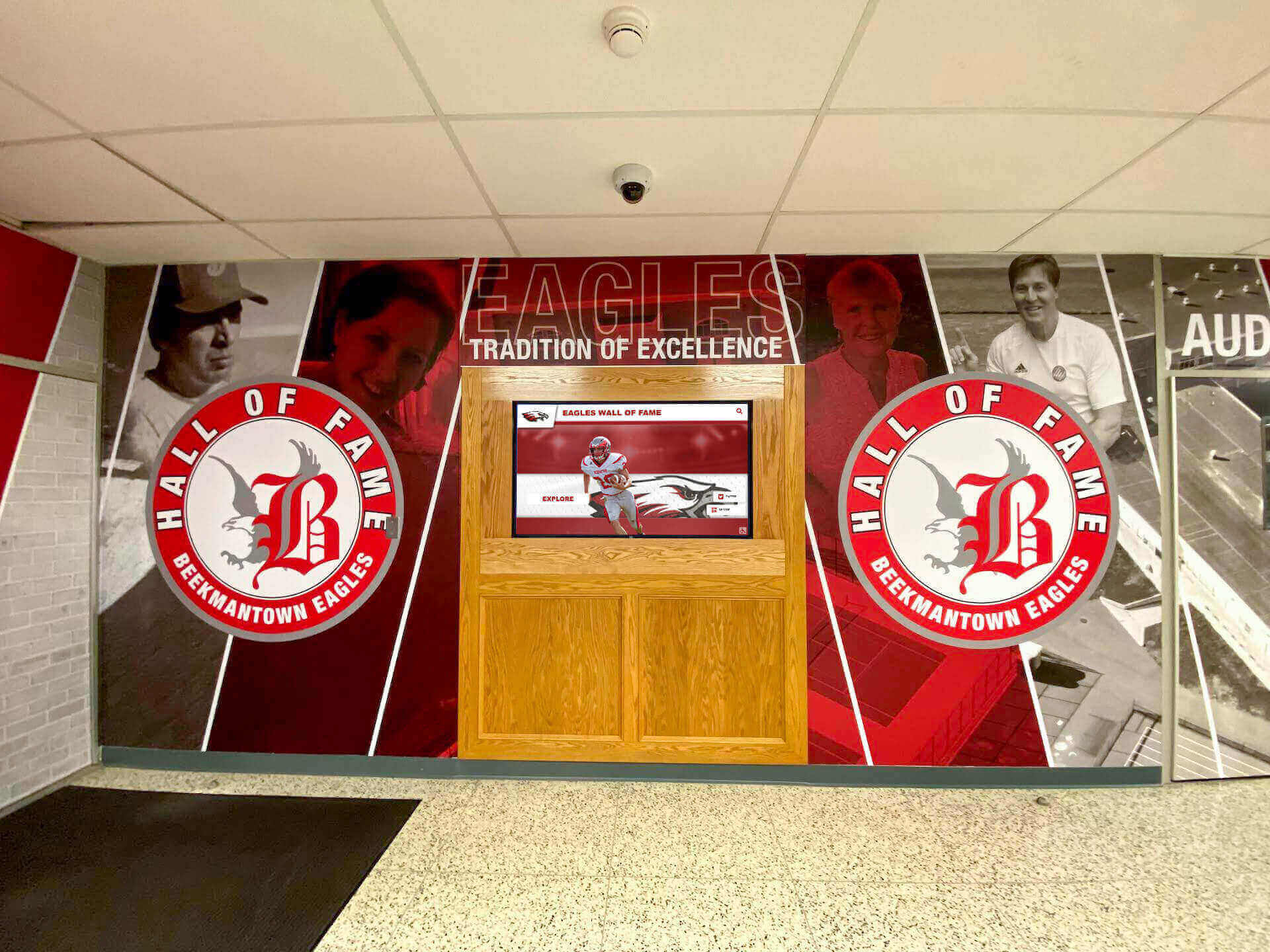
Making the Transition: From Traditional to Digital Record Boards
Schools successfully transitioning from traditional to digital record boards follow systematic approaches that ensure smooth implementation and long-term satisfaction.
Phase 1: Planning and Assessment
Inventory Current Records: Document all records currently displayed on traditional boards. Photograph boards to ensure accuracy during transition. Identify which records are documented with supporting information (programs, newspapers, coach records) and which may need research or verification.
Identify Hidden Records: Many schools discover significant records stored in filing cabinets, old record books, or coach memories that never made it onto traditional boards due to space constraints. This transition creates the perfect opportunity to research and document comprehensive record history.
Determine Priorities: Decide whether to launch with comprehensive historical records or start with recent records and add historical data over time. Many schools take a phased approach—ensuring current records are complete and accurate immediately, then systematically adding historical records over subsequent months.
Engage Stakeholders: Discuss the transition with coaches, athletic boosters, and alumni. Address any concerns about honoring traditional boards and explain how digital systems enhance rather than replace recognition. Consider ceremonial decommissioning of traditional boards, perhaps creating display pieces for athletic offices using portions of historic boards.
Phase 2: Content Development
Digitize Existing Information: Transfer current records from traditional boards to digital format. Verify accuracy through multiple sources when possible—especially for older records where errors may have propagated over years of manual updates.
Gather Photos: Collect athlete photos from yearbooks, team photos, action shots from competitions, and personal collections. Even historical records become more engaging with photos. Alumni often enthusiastically contribute images when asked.
Research Historical Context: Add details beyond basic records—championship context, significant performances that didn’t set records, coaching tenures, facility histories. This rich context makes records more meaningful and interesting.
Create Organizational Structure: Use Rocket Alumni Solutions’ sport templates as starting points, customizing categories to match your program’s specific needs and traditions. Ensure naming conventions stay consistent across sports for professional presentation.
Phase 3: Implementation and Launch
System Setup and Customization: Work with Rocket Alumni Solutions to configure the system with your school colors, logos, and branding. Set up user accounts for staff who will manage content. Upload initial content and test thoroughly.
Staff Training: Rocket provides training for athletic directors, coaches, and administrators who will update content. Ensure multiple staff members understand the system so record updates don’t depend on single individuals.
Soft Launch Period: Run the system for 2-4 weeks before official announcement, allowing staff to identify any issues, make adjustments, and become comfortable with operations. Gather feedback from early users.
Grand Opening Event: Time the official launch with a significant athletic event—homecoming, senior night, playoff game, or sports banquet. Create ceremony acknowledging both traditional board history and exciting digital future. Demonstrate interactive features and encourage exploration.
Many successful implementations are covered in guides about building school pride through recognition, showing how digital record boards contribute to overall culture.
Phase 4: Ongoing Management
Establish Update Routines: Create processes for timely record updates. Coaches submit record-breaking performances to athletic directors within 48 hours. Athletic directors update the digital system within one week. Regular updates maintain accuracy and engagement.
Seasonal Reviews: At the end of each sport season, review all records for that sport. Add any records that were broken but not yet updated. Enhance content with season photos, championship information, and athlete profiles.
Continuous Enrichment: Systematically add historical content, filling gaps in record coverage. Reach out to alumni for photos and stories. Add video highlights when available. The living nature of digital systems means content can continually improve over years.
Monitor Engagement: Use system analytics to understand how visitors interact with records. Which sports are most popular? What search terms do users enter? Are certain eras of history particularly interesting? Use these insights to prioritize content development.
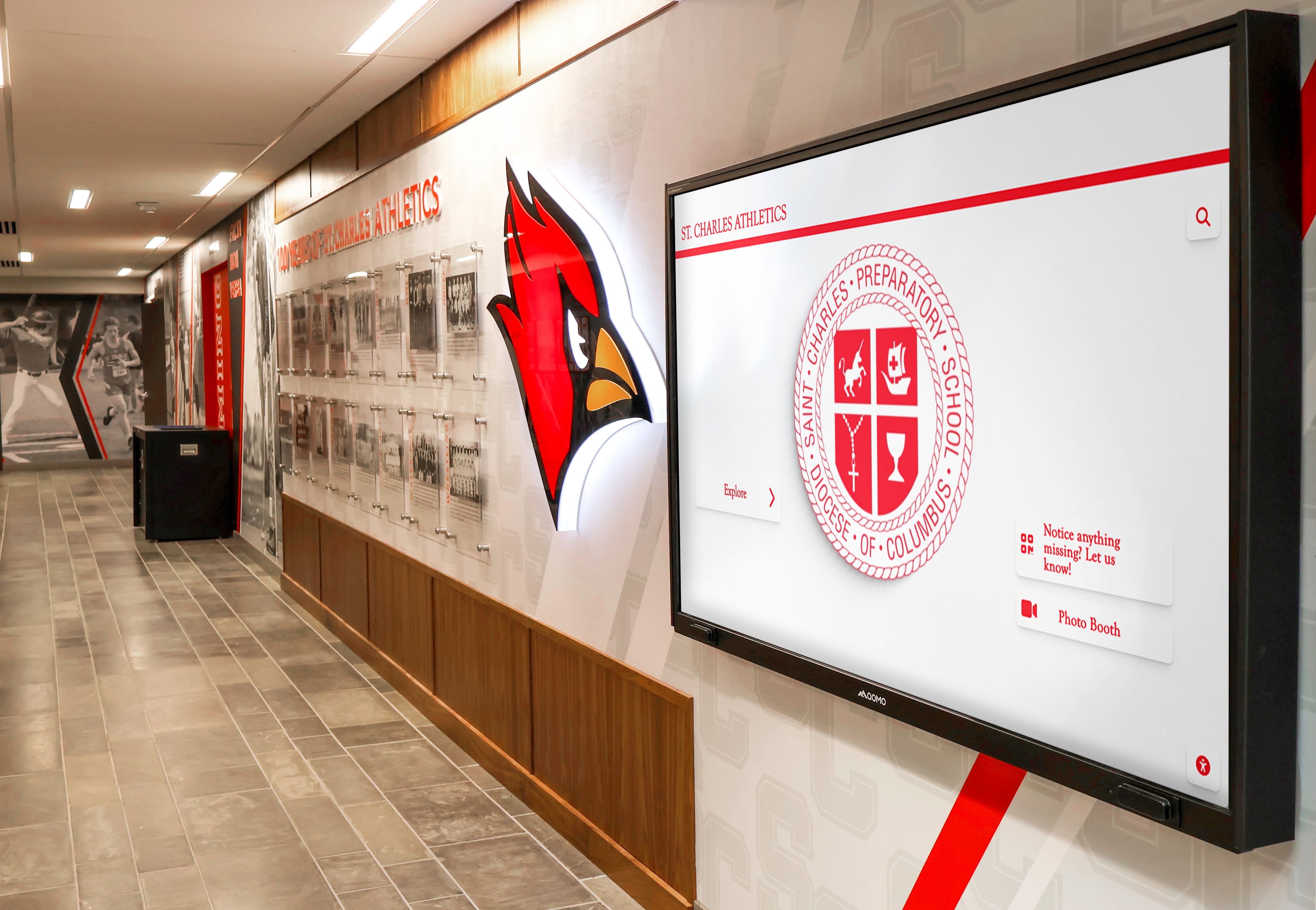
Specific Benefits Schools Experience After Implementation
Schools that have implemented Rocket Alumni Solutions digital record boards report consistent benefits across athletic programs of all sizes.
Records Stay Current and Accurate
The easiest benefit to measure: records are updated far more quickly and remain accurate throughout the season.
Before digital systems, schools commonly went entire seasons with outdated information on traditional boards. Records broken in September might not appear until April when time and budget allowed physical board updates. Multiple season records might accumulate as backlogs, frustrating athletes whose achievements went unrecognized for months.
After implementing digital systems, schools update records within days of achievements. The simple update process means delays of months become delays of days at most. This timely recognition maximizes motivational impact for current athletes while demonstrating that the athletic program values and celebrates excellence immediately.
Accuracy improves dramatically as well. Digital systems eliminate transcription errors from physical installation. Records are entered once into the system and display consistently across all interfaces. Corrections take minutes rather than requiring new physical materials and reinstallation.
Student Engagement Increases Substantially
Traditional record boards receive brief glances—students look at them a few seconds while walking past. Digital record boards create genuine engagement—students stop, interact, and explore for several minutes.
Schools report students regularly using digital record boards to:
- Search for their own names and achievements
- Look up teammates’ performances and records
- Research school history and past championship teams
- Show parents and relatives their recognition during school events
- Compare current and historical records
- Discover connections between current and historical athletes (siblings, relatives, coaches)
This extended engagement means records actually fulfill their intended purpose—inspiring current athletes, building pride in program tradition, and creating connections across generations.
Interactive features like touchscreen recognition displays transform passive viewing into active discovery, fundamentally changing how students connect with athletic history.
Program Recruitment Benefits
Athletic directors report that digital record boards provide unexpected recruitment advantages during campus tours and recruiting visits.
Prospective student-athletes and their families consistently express positive impressions when they see comprehensive, professional digital record displays. The systems communicate several implicit messages:
- The school values athletic achievement and invests in recognition
- The program has depth and tradition across multiple sports and decades
- Excellence is documented, celebrated, and maintained long-term
- The school embraces modern technology and best practices
These impressions matter. When prospects are choosing between similar programs, professional recognition systems demonstrating program pride and tradition can influence decisions.
Coaches use digital displays during recruiting conversations, showing prospects exactly where program records stand, highlighting recent achievements, and connecting current opportunities to historical success. The systems become recruiting tools that tell program stories more compellingly than coaches’ words alone.
Alumni Connections Strengthen
Digital record boards create new touchpoints for alumni engagement.
Many schools share digital record board content through alumni newsletters and social media, allowing graduates to see their achievements still recognized and celebrated years or decades after graduation. Alumni visit campus specifically to see digital displays and show their families, creating opportunities for athletic departments to maintain and deepen alumni relationships.
Some implementations include web-based access, allowing alumni to explore school records remotely from anywhere in the world. This extended access keeps alumni connected to programs even when geographic distance prevents physical campus visits.
Schools report increased booster contributions and alumni involvement following digital record board implementations, as alumni feel their achievements and legacies remain visible and valued by current programs.
Administrative Burden Decreases
Perhaps the most appreciated benefit by busy athletic directors: digital record boards require far less time and mental energy than traditional systems.
The physical process of traditional board updates—tracking down contact information for sign companies, getting quotes, submitting purchase orders, scheduling installation, verifying quality, processing invoices—consumed hours per record update. Multiplied across dozens of annual updates, the administrative burden was substantial.
Digital updates take minutes and require no coordination with external vendors. Athletic directors update records themselves from their desks in less time than it takes to send a few emails. This efficiency means records stay current without adding to already-packed schedules.
The decreased administrative burden also means record updates happen more reliably. When updates are time-consuming, they get postponed during busy seasons. When updates take minutes, they happen promptly regardless of schedule demands.

Advanced Features That Enhance Record Recognition
Beyond basic record display, Rocket Alumni Solutions includes advanced features that create richer experiences and extend recognition value.
Multimedia Integration
Digital platforms excel at combining multiple content types:
Photo Galleries: Create comprehensive visual documentation of achievements. Include individual athlete photos, team photos, action shots from record-breaking performances, and celebration images. Multiple photos per record tell complete stories that single images cannot.
Video Highlights: Embed video clips of record-breaking performances when available. Championship races, record-breaking plays, state meet highlights, and historical footage create emotional connections and bring achievements to life for viewers who weren’t present for original performances.
Historical Documents: Scan and display newspaper clippings, meet programs, historical correspondence, or other documents providing context and authenticity to records. These artifacts add legitimacy and historical interest, especially for older records that predated modern media coverage.
Searchable Historical Database
Comprehensive search capabilities transform record boards from static displays into research tools:
Search Options:
- Athlete name search finding all records held by specific individuals
- Year search showing all records set in particular seasons
- Sport filtering narrowing to specific athletic programs
- Record type filtering (individual, relay, team records)
- Championship search finding state, conference, sectional achievements
- Coach search showing records set during specific coaching tenures
This searchability serves multiple purposes: students research program history for projects, coaches analyze program trends, media access information for stories, and alumni locate their achievements or teammates’ records easily.
Automated Record Progressions
Digital systems can automatically show how records evolved over time:
Track how the 100-meter dash record improved over decades, showing each athlete who held the record and how long it stood. These progressions demonstrate program development and contextualize current achievements within historical trajectories.
Record progression displays often become particularly engaging content, as viewers see the step-by-step improvement that marks program excellence and discover which records have stood for decades versus those that change frequently.
Mobile and Web Access
Rocket Alumni Solutions can extend record board content beyond physical displays:
Web Portals: Embed record content on official athletic websites, making information accessible to anyone, anywhere. Prospective student-athletes, alumni, media, and community members can explore records without visiting campus.
Mobile Responsiveness: Web-based access automatically adapts to smartphones and tablets, ensuring excellent user experiences regardless of device. Visitors can explore records while attending events, share specific achievements on social media, and access information conveniently.
This extended access multiplies the recognition value of content. Athletic departments invest effort once to create comprehensive records, then that content serves multiple purposes across physical displays, websites, and mobile access.
Analytics and Insights
Understanding how people interact with record displays helps optimize content:
Usage Metrics:
- Total interactions and viewing time
- Most-searched athletes and sports
- Peak usage times and days
- Geographic distribution of web users
- Content gaps (searches returning no results indicating missing information)
Schools use these insights to prioritize content development, understand what resonates with audiences, and demonstrate value when justifying continued investment in recognition systems.
Real-World Implementation Examples
While specific client details require permission to share, the patterns of successful implementation across hundreds of schools are clear.
Small School Success
Small high schools (300-500 students) often question whether digital record boards make sense for smaller athletic programs. Implementation experiences demonstrate the value scales to all program sizes.
Small schools particularly benefit from unlimited capacity—they can finally showcase complete program history rather than selecting only “most important” records for limited traditional board space. Recognition across all sports receives equal treatment, addressing historical imbalances where minor sports received minimal recognition.
Smaller budgets make the update simplicity especially valuable. Schools without dedicated athletic director assistants rely on coaches to manage records. The easy update process makes this practical where physical board maintenance was often neglected due to time and cost constraints.
Many small schools report that digital record boards become signature elements of athletic facilities, creating outsized impact on program perception and pride relative to the investment. The professional presentation demonstrates commitment to excellence that resonates with prospective students and community supporters.
Large Program Comprehensive Systems
Large high schools (1,500+ students) with extensive athletic programs face different challenges—massive record volumes across 20-30 sports programs, multiple facilities requiring recognition displays, and complex administrative structures.
Digital systems prove essential for managing this complexity. The ability to organize hundreds of records per sport, maintain accuracy across programs, and update efficiently from centralized management makes comprehensive recognition practical where traditional boards created overwhelming administrative burden.
Large schools often implement multiple displays—main gymnasium for major sports, natatorium for aquatics programs, field house for track & field, wrestling room for wrestling history. Rocket Alumni Solutions’ centralized management means one person can update all displays simultaneously, maintaining consistency despite physical separation.
The analytics capabilities help athletic directors understand engagement across different sports and displays, informing decisions about content development priorities and potential additional display locations.
Multi-Building Campus Networks
Some schools span multiple buildings or campuses (high school plus middle school, multiple high schools in districts). Digital record board networks serve these distributed environments effectively.
Centralized content management means district athletic directors maintain single databases serving multiple displays across different locations. Each building receives appropriate content—high school records in high school, middle school records in middle school, combined highlights in athletic administration offices.
This distributed approach creates more touchpoints for recognition, reaching students and visitors in multiple locations while maintaining efficiency through unified management.
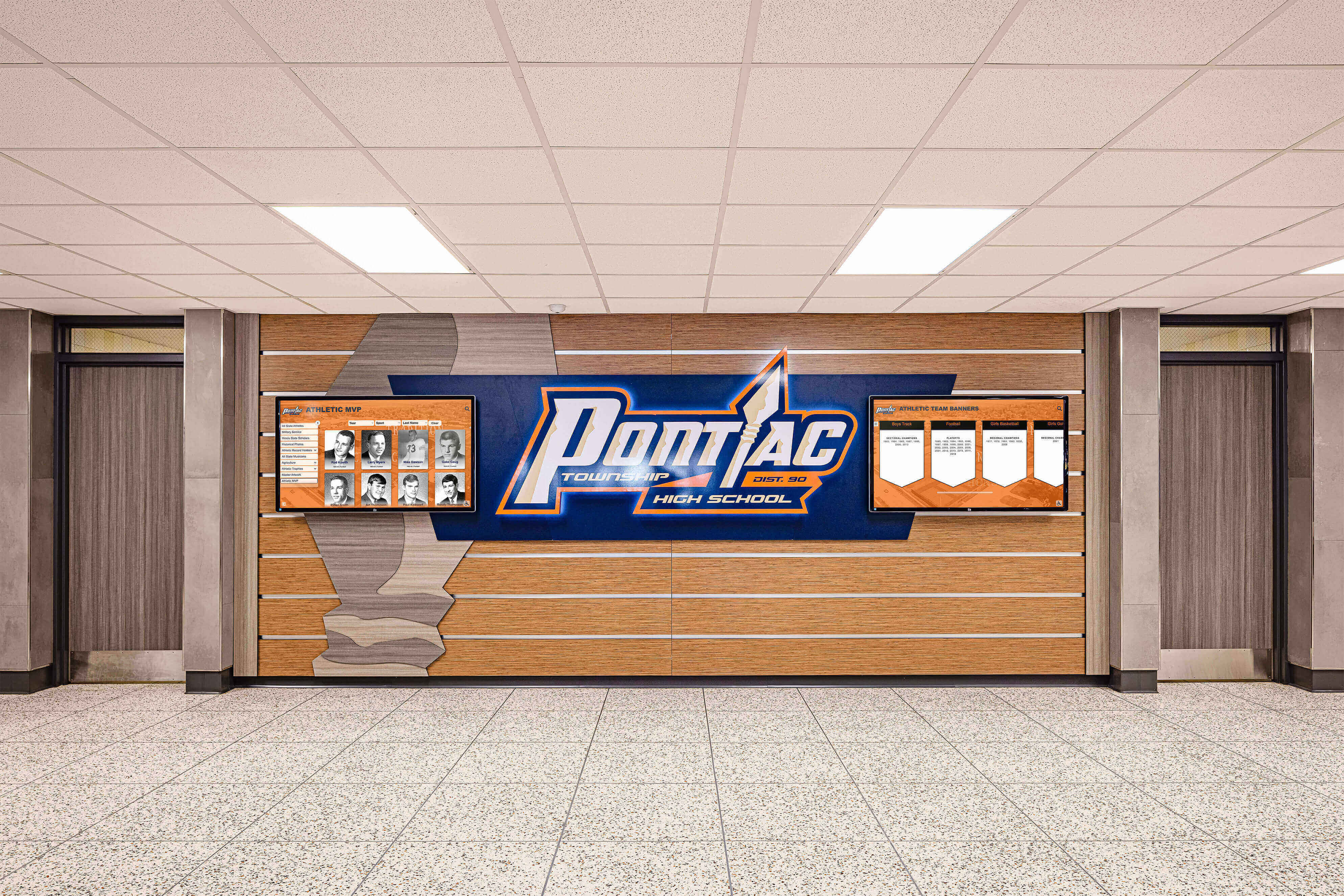
Addressing Common Questions and Concerns
Schools considering digital record boards frequently raise similar questions. Understanding these concerns and their practical answers helps inform decision-making.
“What If Technology Fails?”
Technology reliability concerns are legitimate but typically overstated based on consumer electronics experience rather than commercial-grade system reality.
Rocket Alumni Solutions uses commercial displays designed specifically for continuous public operation. These systems carry 50,000+ hour operating ratings (15+ years of daily use) and demonstrate 98-99% uptime in typical deployments.
Technical support quickly resolves the rare issues that do occur. Cloud-based content management means display problems don’t cause data loss—once resolved, content appears exactly as before. Warranties and support agreements provide protection and rapid response ensuring minimal disruption.
Compare this to traditional boards, which also require maintenance and eventually need complete replacement, without providing the capabilities and ease of use digital systems deliver.
“Will Content Migration Be Difficult?”
Content migration proves far simpler than most schools anticipate. The process typically follows:
- Document existing traditional board records (photography and data entry)
- Input records into Rocket system using simple forms
- Add photos from yearbooks or school archives
- Review and publish
For schools with 20-30 sports and 200-400 total records, the process typically requires 20-40 hours of work—often spread across multiple staff or even student helpers. Rocket provides import tools and templates that streamline data entry substantially.
Many schools take phased approaches—ensuring current records are complete immediately, then adding historical records systematically over several months. This spreads the work while still delivering immediate value.
“How Much Training Is Required?”
Initial orientation typically takes 30-60 minutes. The system is genuinely intuitive—designed for athletic directors and coaches, not IT professionals.
Rocket provides training via web conference, walking through all key functions: adding new records, uploading photos, editing existing information, publishing updates, and finding specific content. Video tutorials supplement live training for future reference.
Most schools find that after initial orientation, additional training becomes unnecessary. The system is straightforward enough that new staff members learn through brief observation and experimentation.
“Can We Customize It For Our School?”
Comprehensive customization ensures the system feels like a natural extension of your athletic program:
Customization Options:
- School colors throughout interface and displays
- Logo and mascot graphics prominently featured
- Sport names and categories matching your terminology
- Custom record types for unique school traditions
- Layout designs fitting your brand guidelines
- Special features for signature program elements
Rocket works with schools during setup to implement customization ensuring displays look and feel distinctly yours rather than generic.
“What About Internet Outages?”
Displays include local caching ensuring content continues displaying during network interruptions. Visitors won’t notice issues beyond the inability to perform online-dependent functions during temporary outages.
Content updates require connectivity, but displays themselves operate independently once content is loaded. Network requirements are modest—standard school WiFi or wired networks work perfectly well.
Expanding Beyond Athletic Records
While athletic records represent the most common digital record board application, schools discover broader uses for the platform and technology:
Academic Achievement Recognition
Comprehensive recognition extends beyond athletics:
- Academic Excellence: Honor roll, National Merit Scholars, valedictorians, scholarships
- Academic Competition Success: Math competitions, science olympiad, debate championships
- College Admissions: Top university acceptances, specialized program admissions
- Testing Excellence: AP Scholar recognition, SAT/ACT high scores, state assessment achievements
Schools with academic recognition programs use the same platform and displays serving athletics, creating comprehensive celebration of excellence across all domains.
Arts and Activities Recognition
Fine arts, performing arts, and student activities deserve equal recognition:
- Theater: Show documentation, cast lists, award-winning productions
- Music: Concert highlights, competition results, honor ensemble members
- Visual Arts: Student artwork galleries, competition winners, alumni artists
- Publications: Award-winning journalism, yearbooks, literary magazines
Digital platforms excel at this diverse content through multimedia support, making them ideal for showcasing creative achievements that traditional trophy cases handle poorly.
School History and Traditions
Digital displays become living archives documenting institutional history:
- Facility evolution with historical photos and modern images
- Tradition documentation explaining customs and their origins
- Notable alumni from various fields and achievements
- Homecoming and prom histories through the decades
- School milestone anniversaries and celebrations
This historical content builds school pride and helps students understand they’re part of continuing stories larger than themselves.
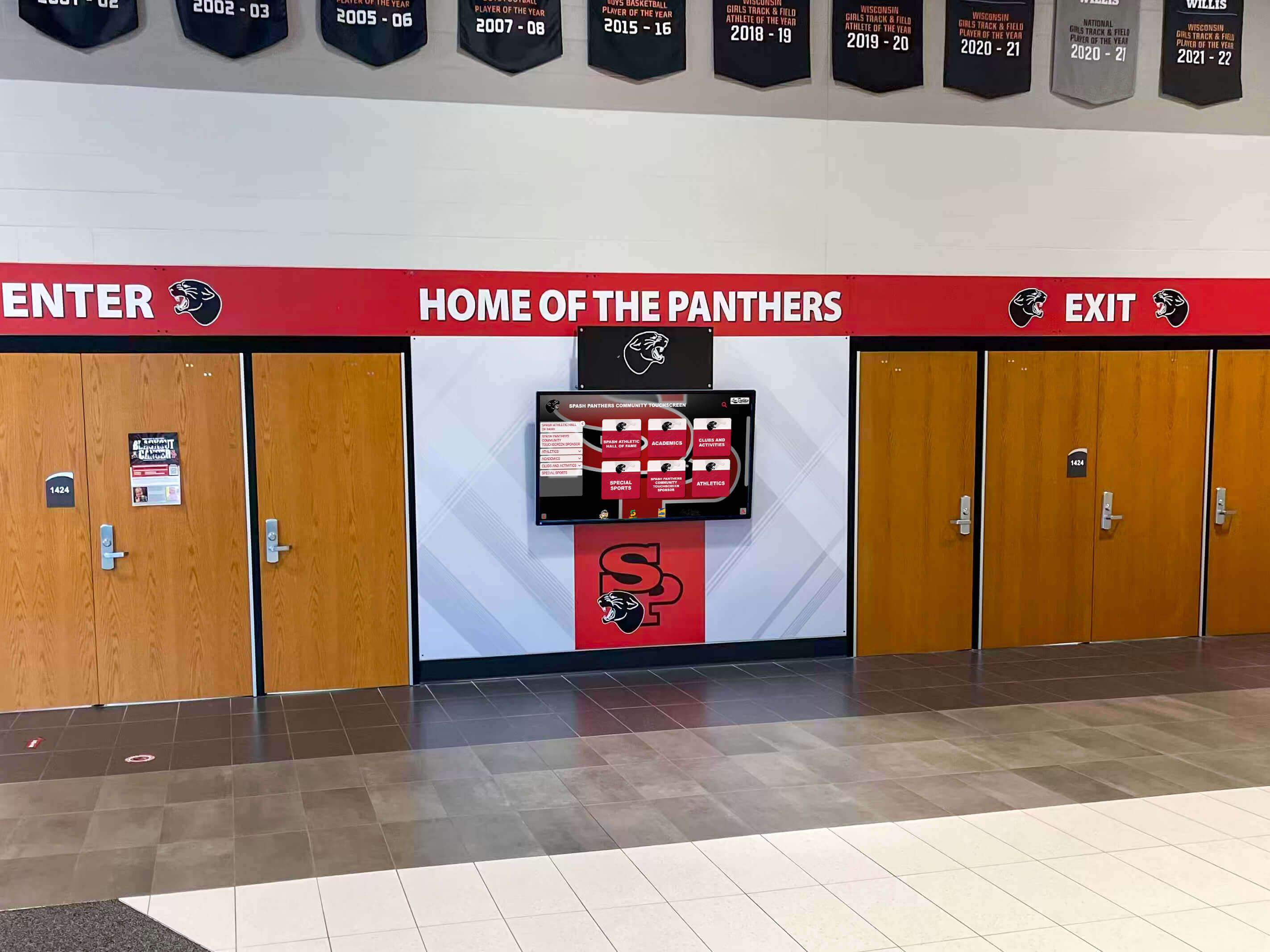
Making the Decision: Is a Digital Record Board Right for Your School?
Digital record boards make excellent sense for schools that:
Clear Fit Indicators:
- Currently use traditional record boards requiring frequent updates
- Want to recognize more records than current space allows
- Value professional, modern recognition presentation
- Desire efficient record management without substantial ongoing labor
- Plan to maintain recognition programs for many years
- Want to increase student engagement with program history
- Seek to strengthen alumni connections through recognition
- Have basic network infrastructure (WiFi or Ethernet)
- Can invest $10,000-20,000 for comprehensive long-term solution
Schools may want to consider phased approaches or alternatives if:
Implementation Caution Indicators:
- Extremely limited budgets requiring focus on core athletic needs first
- Very new programs with minimal record history to display
- Lack basic network infrastructure requiring substantial preliminary work
- Strong sentimental attachment to traditional boards as defining program elements (though hybrid approaches work well)
- Uncertainty about long-term commitment to maintaining digital content
For most schools, digital record boards provide clear advantages in capability, ease of use, and long-term cost-effectiveness compared to traditional alternatives.
Getting Started With Rocket Alumni Solutions
Schools ready to modernize record recognition should follow this process:
Initial Research and Learning
Visit Rocket Alumni Solutions website to explore platform capabilities and see example displays. Many schools find the live interactive demos particularly helpful for understanding user experiences.
Review case examples and testimonials from schools with similar programs and needs. Discuss with athletic directors at other schools who have implemented digital systems—most enthusiastically share their experiences and recommendations.
Request Information and Demonstration
Contact Rocket Alumni Solutions to request personalized demonstrations showing how the system would work for your specific program needs. These consultations address your unique circumstances, budget parameters, and implementation questions.
Demonstrations typically include:
- Live walkthrough of content management system
- Examples of how your sports and records would appear
- Discussion of customization options matching your school
- Review of implementation process and timeline
- Detailed pricing and package options
- Answers to all questions and concerns
Build Internal Support
Engage athletic directors, administrators, coaches, boosters, and alumni in the evaluation process. Address concerns, gather input, and build consensus around implementation.
Develop business case showing long-term value: cost savings from eliminated traditional board updates, comprehensive recognition serving more athletes, professional presentation supporting recruitment, and administrative efficiency from streamlined management.
Identify funding sources—regular budgets, booster clubs, alumni associations, naming opportunities, or phased approaches spreading investment over multiple years.
Implementation Partnership
Once decision is made, Rocket Alumni Solutions partners with your school through implementation:
- System configuration and customization
- Content migration planning and execution
- Hardware installation coordination
- Staff training and resource development
- Launch support and promotion
- Ongoing technical support and updates
Schools aren’t left to figure things out alone. The partnership ensures successful implementation delivering value for years to come.
Conclusion: The Perfect Solution for Modern School Record Recognition
School records deserve recognition systems matching their importance. Athletes work incredibly hard to achieve excellence, and their accomplishments should be celebrated professionally, comprehensively, and permanently—not hidden due to traditional board limitations or languishing in outdated displays because updates are too difficult and expensive.
Digital record boards from Rocket Alumni Solutions provide the perfect solution: remarkably easy to update (minutes instead of hours), minimal maintenance requirements (no more vinyl, engraving, or physical installation), unlimited capacity to recognize every achievement, rich multimedia storytelling impossible with traditional boards, and cost-effective long-term value that favors digital over traditional alternatives.
Hundreds of schools across the country have discovered that transitioning to digital record boards is far easier than anticipated and delivers benefits exceeding initial expectations. Records stay current, student engagement increases, administrative burden decreases, and athletic programs present themselves professionally in ways that build pride and tradition.
The decision to modernize record recognition is not whether digital systems are superior—they demonstrably are—but rather when to make the transition and how to fund it strategically. Schools making this investment consistently report satisfaction and wonder why they didn’t make the change sooner.
Ready to transform your school’s record recognition with a solution that’s easy to update and maintain? Rocket Alumni Solutions provides comprehensive digital record board platforms specifically designed for schools, combining intuitive management, engaging displays, and ongoing support that ensures long-term success. Stop struggling with traditional record boards and start celebrating every achievement the way your athletes deserve.
